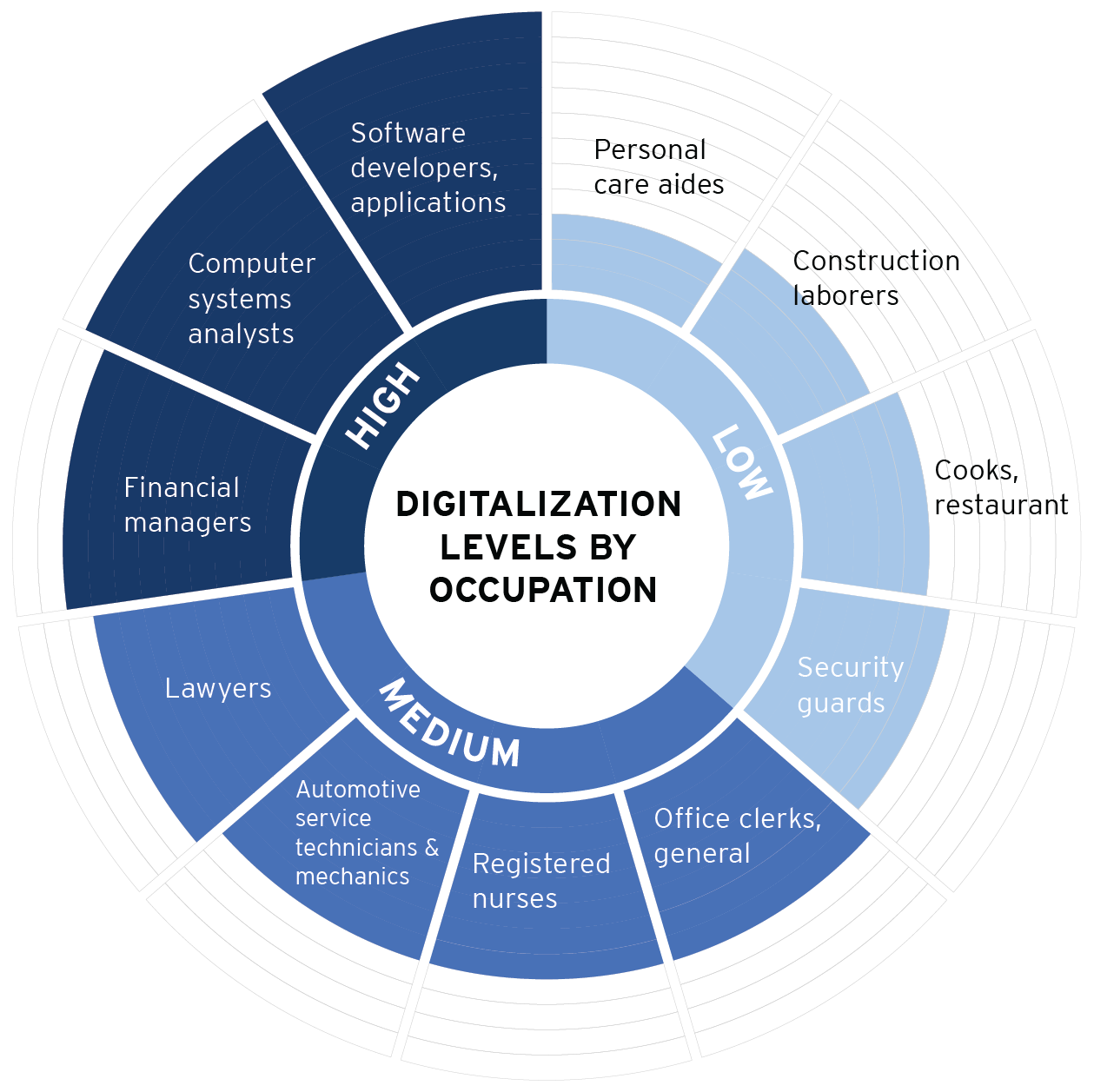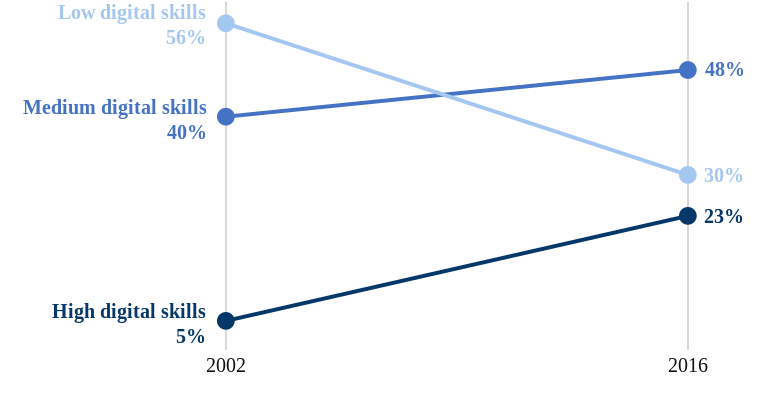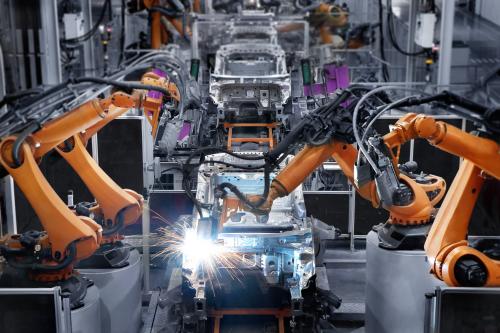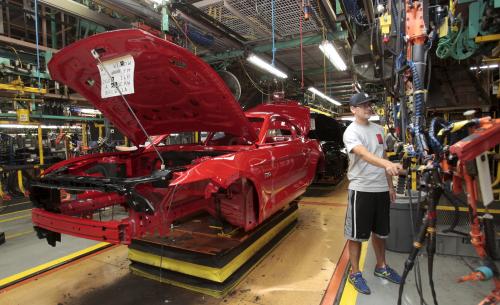- Mark Muro
- Sifan Liu
- Jacob Whiton
- See More
More On
In recent decades, the diffusion of digital technology into nearly every business and workplace, also known as “digitalization,” has been remaking the U.S. economy and the world of work. The “digitalization of everything” has at once increased the potential of individuals, firms, and society while also contributing to a series of troublesome impacts and inequalities, such as worker pay disparities across many demographics, and the divergence of metropolitan economic outcomes.
In light of that, this report presents a detailed analysis of changes in the digital content of 545 occupations covering 90 percent of the U.S. workforce in all industries since 2001. The analysis categorizes U.S. occupations into jobs that require high, medium or low digital skills and tracks the impacts of rapid change.
The full report concludes with implications of the key findings and suggests ways communities can work with firms and workers to spread the benefits of digitalization while mitigating its potentially harmful effects. Read about the report’s primary recommendations on page 38 »
The U.S. economy is digitalizing at an extremely rapid pace.
Select occupations and digital skill level, 2016

Between 2002 and 2016, the shares of U.S. jobs that require substantial digital knowledge rose rapidly, mostly due to large changes in the digital content of existing occupations. Read more about the changing U.S. workforce on page 15
Workers of every stripe—from corporate finance officers to sales people to utility workers and nurses—are now spending sizable portions of their workdays using tools that require digital skills.
Source: Brookings analysis of O*Net, OES, and Moody’s data.
Share of jobs in low, medium, and high digital skill occupations
2002 and 2016

In 2002, 56 percent of the jobs studied required low amounts of digital skills. Nearly 40 percent of jobs required medium digital skills and just 5 percent required high digital skills.
A lot has changed. By 2016, the share of jobs requiring high digital skills had jumped to 23 percent. The share requiring medium digital skills rose to 48 percent. And in a huge shift, the share of jobs requiring low digital skills fell from 56 to 30 percent.
Source: Brookings analysis of O*Net, OES, and Moody’s data.
The degree and pace of change of digitalization varies widely among occupations and across industries.
Digitalization scores rose in 517 of 545 analyzed occupations from 2002 to 2016. At the same time, the degree and pace of change has varied widely. The average digitalization score across all occupations rose from a low level of 29 in 2002 to a medium level of 46 in 2016, a 57 percent increase.
Digital skills levels and change in digital skills for 545 occupations
United States
Additionally, virtually all industry groups saw their mean digital scores increase from 2002 to 2016, though the degree and speed of digital adoption varies significantly. Leading the digitalization race is a group of broad service sectors, including professional, scientific and technical services (55); media (52); and finance and insurance (55). On the lower end, education, transportation and warehousing, basic goods manufacturing, and construction have scores mostly in the 30s. Read more about the changing digital scores of diverse industries on page 17
Digitalization is associated with increased pay and job resiliency in the face of automation but also vastly uneven trends for job growth and wages. Sharp gender- and race-based challenges also exist.
Job growth
Job growth has been rapid in high-digital level occupations, such as computer-mathematical and business-finance occupational groups, as well as in low-digital level occupations, such as personal care and food preparation. By contrast, middle-digital occupations, such as office-administrative and education occupations have seen much slower job growth. Read more about the correlation between digitalization and job growth on page 24
Wages
The mean annual wage for workers in high-level digital occupations reached $72,896 in 2016, whereas workers in middle-level digital jobs earned $48,274 on average, and workers in low-level digital occupations earned $30,393 on average. Read more about the correlation between digitalization and wages on page 21
Automation
Digitalization provides a degree of protection for workers against task displacement through automation. While nearly 60 percent of tasks performed in low-digital occupations appear susceptible to automation, only around 30 percent of tasks in highly digital occupations appear susceptible to automation. Read more about the correlation between digitalization and automation on page 22
Wage growth
Between 2010 and 2016, occupations with high-level digital scores on average registered more than 0.8 percent wage growth annually, compared to middle-level annual wage growth of 0.3 percent, versus annual wage declines of 0.2 percent for low-level occupations. Read more about the correlation between digitalization and wage growth on page 24
Gender
Women, with slightly higher aggregate digital scores (48) than men (45), represent about three-quarters of the workforce in many of the largest medium-digital occupational groups, such as health care, office administration, and education. Conversely, men continue to dominate the highest-level digital occupations, such as computer, engineering and management fields, as well as lower-digital occupations such as transportation, construction, natural resources, and building and grounds occupations. Read more about the correlation between digitalization and gender on page 35
Race/ethnicity
Whites (65 percent of the workforce) remain overrepresented in high-level digital occupational groups, such as engineering and management, as well as medium-level digital areas such as business and finance, the arts, and legal and education professions. Asians (6 percent of the workforce) account for 21.3 percent of highly digital computer and math occupations, and 11.6 percent of engineering occupations. Blacks (12 percent of the workforce) are overrepresented in medium-digital occupations such as office and administrative support, community and social service, as well as low-digital level jobs such as transportation, personal care, and building and grounds maintenance. Hispanics (17 percent of the workforce) are significantly underrepresented in high-level digital technical, business and finance occupational groups, and somewhat underrepresented in medium-level legal, sales, and education positions. Read more about the correlation between digitalization and race/ethnicity on page 35
Metropolitan area digitalization is ubiquitous, but uneven.
Digitalization is happening everywhere, but its progress varies widely across the map. In this regard, while localities’ mean digital scores are converging, their shares of highly digital workers are diverging. As such, states’ and metros’ mean digital scores and shares of highly digital workers are correlated with significant wage variations at the state and local levels. Read more about the variance in regional digital performance on page 27
Data visualization produced by Alec Friedhoff.
Related Content

Mark Muro
August 14, 2017

Mark Muro, Jacob Whiton
October 17, 2017

Mark Muro
June 19, 2017
Authors
The Brookings Institution is committed to quality, independence, and impact.
We are supported by a diverse array of funders. In line with our values and policies, each Brookings publication represents the sole views of its author(s).






